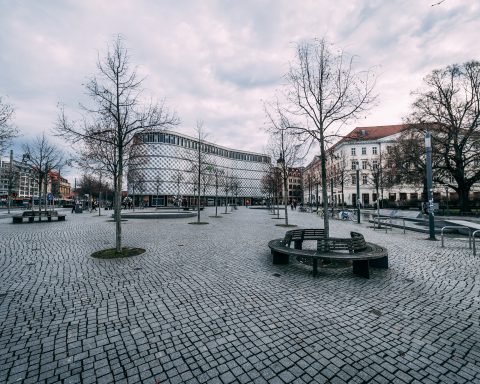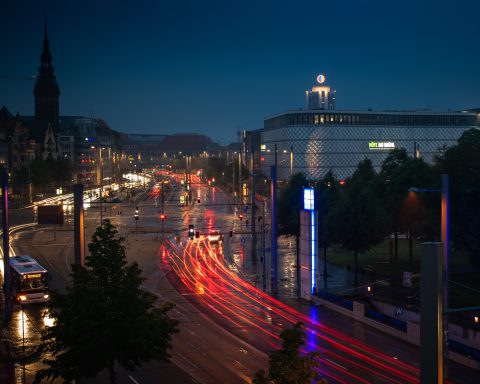You may well have noticed the blue signs at significant buildings in Leipzig’s city centre, or maybe even the metal shapes on the streets guiding explorers through the city of music. The Leipziger Notenspur (“Leipzig Music Trail”) aims to put the city and its people in touch with its music: the self-guided walking tour takes you to architectural sights and public spaces connected with Leipzig’s long musical history and array of personalities.
From Telemann to Bach, Mendelssohn to Schumann and Wagner to Grieg, the sheer number and range of iconic international musicians (and masterpieces) connected to Leipzig is on a scale only comparable with Vienna.

The Notenspur came into being in 2005. It was the brainchild of Werner Schneider, a now semi-retired physics professor at the University of Leipzig, who told me about the long journey to the realisation of the project.
“The idea came into existence about 20 years ago,” he says. “My wife is a great fan of Schumann and was saddened to see the former residence of Schumann in such disrepair.”
The question then was how to draw attention to the significance of the house; how it could be presented and its significance re-established. The process was not without its difficulties, and the project was rejected twice by the City of Leipzig.
Since its inauguration 12 years ago, the Notenspur project has expanded and developed.
The association now boasts two walking trails, a longer bike trail taking you to locations further outside the city centre, as well as a Jewish Discovery Pass, actively teaching school children about the sad history around Jewish culture in the Leipzig music world.
The Music Ride and the Music Walk are still in the planning phase: they are not yet physically marked in the city space and do not have audio and music samples yet. It will take at least five years before they become as ‘visitor friendly’ as the Music Trail.
Given the extent of the Notenspur project, it may come as a surprise to learn that the organisation has only one paid employee. The rest of the work – putting together texts, marketing, event organisation, translation, graphic design, sponsoring, and more – is carried out by a range of dedicated volunteers, up to 20 for some projects.
Schneider says that it is important that everyone is doing meaningful work. And the project is so rewarding that the volunteers are fully invested in it.
The depth of the musical culture and history which Leipzig has to offer is just waiting to be unlocked. To be part of a growing project, bringing this to a wider audience and preserving its material ‘traces’, is most worthwhile.

Notenspur is financed via various different sources, from membership fees and private donations, to sponsorship by the Sparkasse Leipzig as well as funding from the City of Leipzig and Saxony’s Ministry for Economy and Tourism, and for Science and Culture.

The Leipzig Music Trail and the City of Leipzig are now collaborating on Leipzig’s bid for the European Heritage Label.
The designation was established in 2011 by the European Union to recognise sites specifically for their symbolic value, the role they have played in European history, and activities they offer that bring the European Union and its citizens closer together. Leipzig is also one of eight German cities vying to be European Capital of Culture in 2025.
When Derry, Northern Ireland, became the UK Capital of Culture in 2013, tourism was boosted by 50%. In 2014, Leipzig had almost 400,000 overnight visitors. If Leipzig wins the bid, it can only be expected that the subsequent marketing of the city will attract more visitors. At the moment, the city is relatively unspoilt by mass tourism, the city centre remaining calm even during summer months.
You can enjoy the Music Trail for free and as such it is difficult to estimate how many people have made use of it.
While sceptics may point to the destructiveness that mass tourism has on cities, Schneider makes it clear that neither the bid, nor the Notenspur project is simply about attracting tourists. Both are, rather, “identity projects”: building up means of communication between the city and its citizens, drawing not only visitors, but also locals to the rich culture and musical heritage the city quietly boasts. In this sense, the participants are ‘bearers of culture.’
Leipzig may now be renowned for its techno music scene, with clubs such as the Institut fuer Zukunft attracting talent from far and wide, just as Leipzig attracted renowned classical musicians in previous centuries.
Schneider says that over time music is forgotten; the Music Trail is an attempt to actively bring it back to the attention of the population and to give new meaning and visualisation to locations around the city. In particular, the Jewish music culture project seeks to “re-naturalise” its former Jewish citizens who were so horrifically excluded from society by the Nazis.

The level of personal investment in the project is clear to see. From my own experience, translating documents and information for parts of the trail as a volunteer, I have learnt more about Leipzig and its history than I have in many months living here and several museum visits. The beauty of the Notenspur is that it can be actively enjoyed, with not only the sight and intellectual senses being awakened, but with the possibility of hearing music samples at each location, or imagining the songbird in a Leipzig park which inspired one of Mahler’s melodies.

You can start the Leipzig Music Trail at the Gewandhaus in Augustplatz. You can find information about the different stations and audio clips on the website, where you can also read more about the project. Use the metal shapes on the city’s pavements to help you find your way!
‘Like’ the Facebook page to keep up with Notenspur happenings.









